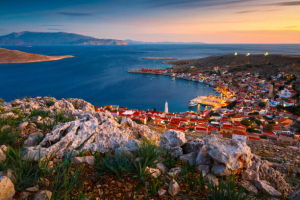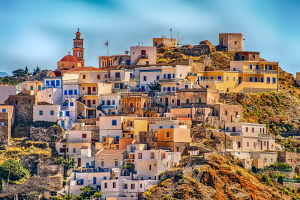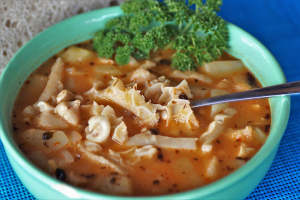ABOUT US
XpatAthens
Top 5 Greek Fall Desserts
Milopita - Greek Apple Pie
@cookingwithtatana
Apples are the trademark fruit of fall and that's why milopita is the ideal dessert for the autumn season. Milopita feels like a warm hug in every bite! The flavors of apples, cinnamon, cloves, walnuts, and raisins together just sound so comforting?
Pasta Flora - Greek Jam Tart

@alwayshungry.gr
Pasta Flora is very popular throughout Greece and is basically a type of jam tart. It's commonly eaten for breakfast as much as it is for dessert. Select the jam of your choice - there are various in-season fruits to choose from - and get baking!
Karidopita - Greek Walnut Cake

@seranobakery
As mentioned before, walnuts are a very popular ingredient for Greek desserts, so make the most of them by preparing delicious karydopita! Made from finely ground walnuts, this famous cake is usually served with ice cream and typically doused with alcohol, and finished with honey syrup. The perfect dessert for your autumn and winter dinner parties!
Rizogalo - Greek Rice Pudding

@pieces_of_greece
Rizogalo - meaning rice and milk in Greek - is the Greek version of the popular rice pudding. Heart-warming and cozy, yet perfectly simple, rizogalo is a staple on chilly autumn and winter nights. It can be served either hot or cold but never without a generous sprinkling of cinnamon on top.
Mosaiko - Greek Chocolate & Biscuits Dessert
@myfamilysfooddiary
For chocolate lovers, mosaico is the perfect Greek dessert! It's simple to create, and it basically entails rolling chocolate biscuits into a buttery chocolate concoction that's then chilled to harden. Toss in some nuts, fruit, or alcohol to your liking!
Halki Island To Turn Green
Children's Activities At The Acropolis Museum
What is truly the Hippalektryon? A rooster or a horse? A real mystery! And what about Centaur, Typhon, Triton and so many others? Visit the Museum with your children (up to 12 years old) and discover them together. Creatures of the earth, the sea and the air, creations of the imagination of ancient people that invite us in a game of exploration, observation and knowledge. Children will be given materials to take home and create their own strange creatures. If they choose to do so, they can photograph their artworks and upload them on acropolismuseum kids!
Greece Launches App For The Storing Of Covid-19 Health Documents
Pangrati Neighborhood Guide
Panathenaic Stadium

Credit: Thomas Gravanis
When Pierre de Coubertin’s vision of reviving the Olympic Games became reality in 1896, the stadium where they would be held was not a random choice. Beneath the marble stands of the 204-meter long oval stadium were the ruins of a 4th century BC arena used for the Panathenaic Games, one of the four major athletic competitions of antiquity, and later by Roman gladiators. A private benefactor, Georgios Averoff, paid to have the stadium beautifully refitted with gleaming white stone from the same Pendeli quarry used millennia earlier to build the Acropolis, thus earning the venue its Greek name - Kallimarmaron, or beautiful marble. If climbing some 50 rows to reach the top of the world’s only all-marble stadium is daunting, walk up Eratosthenous and turn onto Archimidous Street to the rear entrance. This leads to a track around the stadium’s upper rim, a popular training run for local joggers. Follow the path through the Ardittos woods for one of the best views over the centre of Athens and the Acropolis.
Plateia Proskopon

Credit: Thomas Gravanis
Platia Varnava is Pangrati’s hip answer to Platia Proskopon’s entrenched cool. Unlike typical Athens squares, the action isn’t in the middle but on its periphery and the streets around it, stretching as far as the smaller Platia Plastira. The neighborhood’s humbler origins survive in the men chatting idly outside the old-fashioned barber’s just meters from one of the city’s first Michelin-starred restaurants. The cafes and meze bars extend down Empedokleous, a shaded semi-pedestrian street with palm fronds poking over the mulberry trees. Pensioners picking over produce at the Friday farmer's market, which switches seasonally to different sides of the square, mingle easily with tattooed youths sipping freddos from mason jars.
Athens First Cemetery

Credit: Thomas Gravanis
Death and burial have been constant themes in Greek civilization since antiquity. And it’s quite likely that the kitsch plastic wreaths sold at the stands along Anapafseos Street - literally, eternal rest - outside the First Cemetery gates had their counterparts then, too. But this gaudiness does not prepare you for the splendor of the grandiose memorials inside. The 170,00-square-metre necropolis is officially a national museum, as key figures of modern Greek history are buried in many of the 10,000-odd plots. Former prime ministers, film stars, even the German archaeologist Heinrich Schliemann lay buried beneath some remarkable sculpture. Not all memorials are eponymous. A simple bronze statue of a woman clutching a baby to her emaciated body is dedicated to all survivors of the Nazi occupation. Another stand-out among the marble rococo is the grave of poet Costas Varnalis: an avant-garde bronze marked simply: “Peace, the kingdom of human friendship.”
To read this article in full and discover Pangrati's most popular locales, please visit: thisisathens.org
Greece A Leading Choice For European Travelers Seeking To Get Away By March
Panagia Kapnikarea - One Of Athens’ Oldest & Most Historical Churches
Athens English Comedy Club
We also offer 3 free tickets per show to persons with disabilities or unemployed persons (phone reservation required, and the relevant card/proof will be checked at the box office).
The theatre is wheelchair accessible.
Upon entry you will need to provide a vaccination certificate OR negative rapid test from within 48 hours prior to the show, OR a valid proof of recovery/antigen test.
Patsas: Greece's Hangover Soup
Greek Tripe Soup
Patsas is traditionally made from tripe, legs of pig or cow and many also add pig intestines to the recipe. Some people prefer to use beef or lamb, depending on their personal taste.
In Greece, especially in Athens and Thessaloniki, this strong-smelling soup is highly consumed after a big night at the Bouzoukia, as apparently it relaxes the stomach, making it Greece’s favorite hangover food.
It is very common to find people heading to a Patsazidiko, which is a tavern normally found close to the meat markets in the city centre, to eat a bowl of patsas before heading home after a huge night.
Patsatzidika often serves up multiple varieties of this dish. Patsas in the taverns are usually made either with tripe or with feet and the two are occasionally combined and accompanied by other organ cuts, such as the large intestine or pancreas. Greek chefs cut, pre-boil, then simmer the organs for hours to get a soft texture. Then they add salt, pepper, lemon, and sometimes red pepper and onion.
Patsas is sometimes topped with kokkino (fat from the broth mixed with red pepper), skordostoubi (chopped garlic in vinegar), or red pepper shavings.
Tripe soup is also popular in Turkey, Spain, Portugal, and other parts of Europe!
To read this article in full, please visit: greekcitytimes.com
What's Hiding Behind The Four Most Commonly Asked Questions About Goal Setting
Here are the 4 most commonly asked questions regarding goal setting:
- It’s not the right time for me.
- I’m afraid I won’t make it. I won’t succeed.
- I’m not very clear about what it is I want.
- I want to do something different but changes make me feel uncomfortable.
Originally published on: itsmylife.gr










